迭代器模式
2022年5月27日
迭代器模式
学校院系展示需求
编写程序展示一个学校院系结构:
需求是这样,要在一个页面中展示出学校的院系组成,一个学校有多个学院,一个学院有多个系。如图:
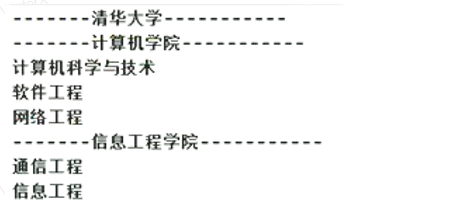
问题分析
- 将学院看做是学校的子类,系是学院的子类,这样实际上是站在组织大小来进行分层次的
- 实际上我们的要求是:在一个页面中展示出学校的院系组成,一个学校有多个学院,一个学院有多个系,因此这种方案,不能很好实现的遍历的操作
- 解决方案:迭代器模式
迭代器模式
基本介绍
- 迭代器模式(lterator Pattern)是常用的设计模式,属于行为型模式
- 如果我们的集合元素是用不同方式实现的,有数组、集合或者其他方式。当客户端要遍历这些集合元素的时候就要使用多种遍历方式,而且还会暴露元素的内部结构,可以考虑使用迭代器模式解决
- 迭代器模式,提供一种遍历集合元素的统一接口,用一致的方法遍历集合元素,不需要知道集合对象的底层表示,即:不暴露其内部的结构
uml类图
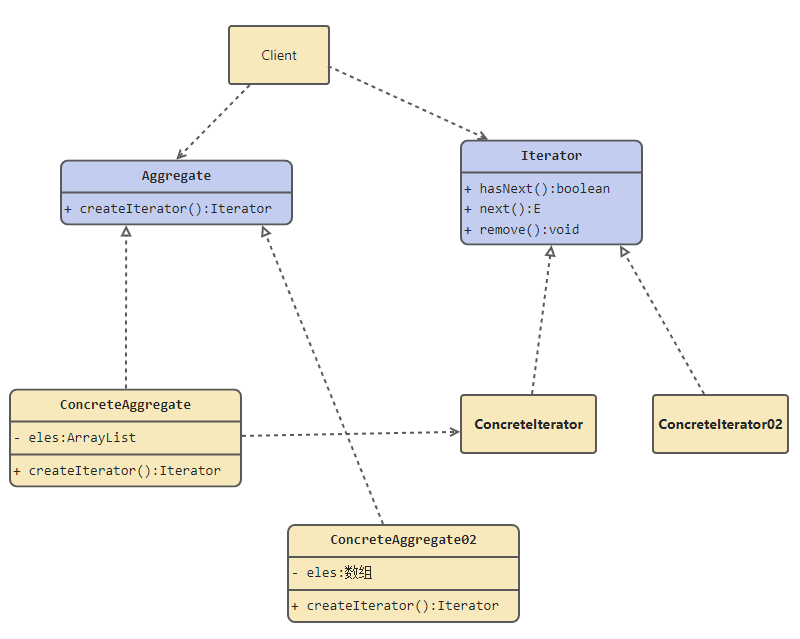
迭代器模式的角色及职责
Iterator迭代器接口:系统提供,含有hasNext、next、removeConcreteIterator具体的迭代器:管理相关的迭代Aggregate聚合接口:将客户端和具体的聚合解耦ConcreteAggregate具体的聚合类:提供一个方法,返回可以正确遍历集合的迭代器Client客户端:通过Iterator迭代器接口和Aggregate聚合接口依赖其具体的迭代器和聚合子类
迭代器完成学校院系结构展示需求
uml类图
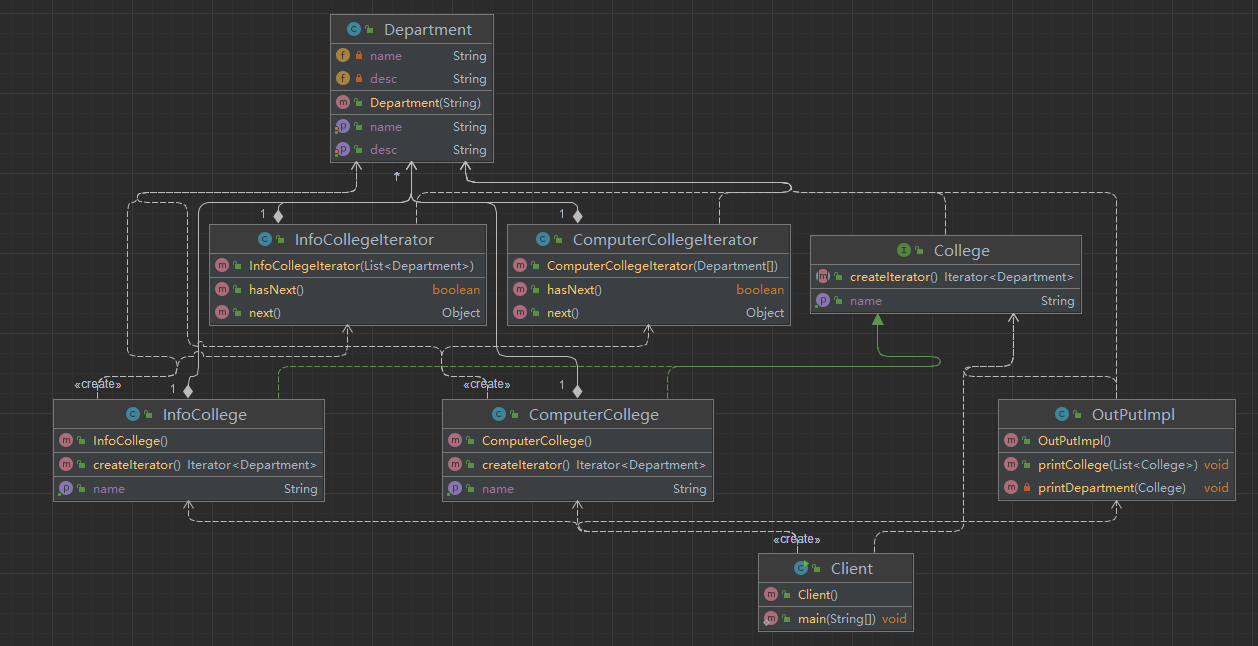
核心代码
public class Department {
private String name;
public Department(String name) {
super();
this.name = name;
}
public String getName() {
return name;
}
public void setName(String name) {
this.name = name;
}
}
//计算机学院迭代器类
public class ComputerCollegeIterator implements Iterator {
private Department[] departments;
private Integer position = -1;
public ComputerCollegeIterator(Department[] departments) {
this.departments = departments;
}
@Override
public boolean hasNext() {
return position + 1 < departments.length && departments[position + 1] != null;
}
@Override
public Object next() {
return departments[++position];
}
}
//信息学院迭代器类
public class InfoCollegeIterator implements Iterator {
private List<Department> departments;
private Integer position = -1;
public InfoCollegeIterator(List<Department> departments) {
this.departments = departments;
}
@Override
public boolean hasNext() {
return position + 1 < departments.size();
}
@Override
public Object next() {
return departments.get(++position);
}
}
//聚合接口
public interface College {
String getName();
Iterator<Department> createIterator();
}
// 具体的聚合类 计算机学院
public class ComputerCollege implements College {
private Department[] departments;
private Integer position = 0;
public ComputerCollege() {
departments = new Department[5];
departments[position++] = new Department("Java专业");
departments[position++] = new Department("PHP专业");
departments[position++] = new Department("Python专业");
}
@Override
public String getName() {
return "计算机学院";
}
@Override
public Iterator<Department> createIterator() {
return new ComputerCollegeIterator(departments);
}
}
// 具体的聚合类 信息学院
public class InfoCollege implements College {
private List<Department> departments;
public InfoCollege() {
departments = new ArrayList<>();
departments.add(new Department("信息安全专业"));
departments.add(new Department("网络安全专业"));
departments.add(new Department("服务器安全专业"));
}
@Override
public String getName() {
return "信息学院";
}
@Override
public Iterator<Department> createIterator() {
return new InfoCollegeIterator(departments);
}
}
//输出类
public class OutPutImpl {
public OutPutImpl() {
}
public void printCollege(List<College> collegeList) {
Iterator<College> iterator = collegeList.iterator();
while (iterator.hasNext()) {
College college = iterator.next();
System.out.println("============" + college.getName() + "============");
printDepartment(college);
}
}
private void printDepartment(College college) {
Iterator<Department> iterator = college.createIterator();
while (iterator.hasNext()) {
System.out.println(iterator.next().getName());
}
}
}
public class Client {
public static void main(String[] args) {
List<College> collegeList = new ArrayList<>();
collegeList.add(new ComputerCollege());
collegeList.add(new InfoCollege());
new OutPutImpl().printCollege(collegeList);
}
}
ArrayList 集合源码分析
uml类图
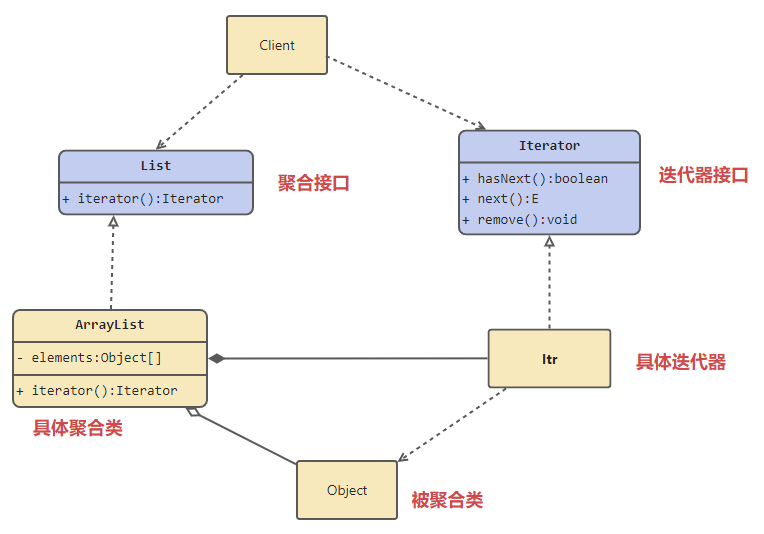
Iterator迭代器接口:由系统提供,定义了hasNext()和next()等方法Itr具体的迭代器实现类:作为ArrayList的内部类存在,实现了Iterator接口的hasNext()和next()等方法List聚合接口:定义了iterator()方法,返回一个迭代器接口对象ArrayList具体的聚合类:实现了iterator()方法
迭代器模式提供了一个不同集合类型(如ArrayList、LinkedList等)的统一遍历解决方案
核心代码
具体聚合类:返回可以正确遍历集合的迭代器
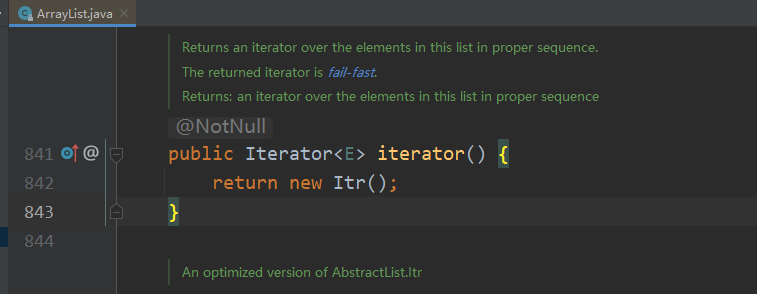
具体迭代器类:实现了迭代器接口
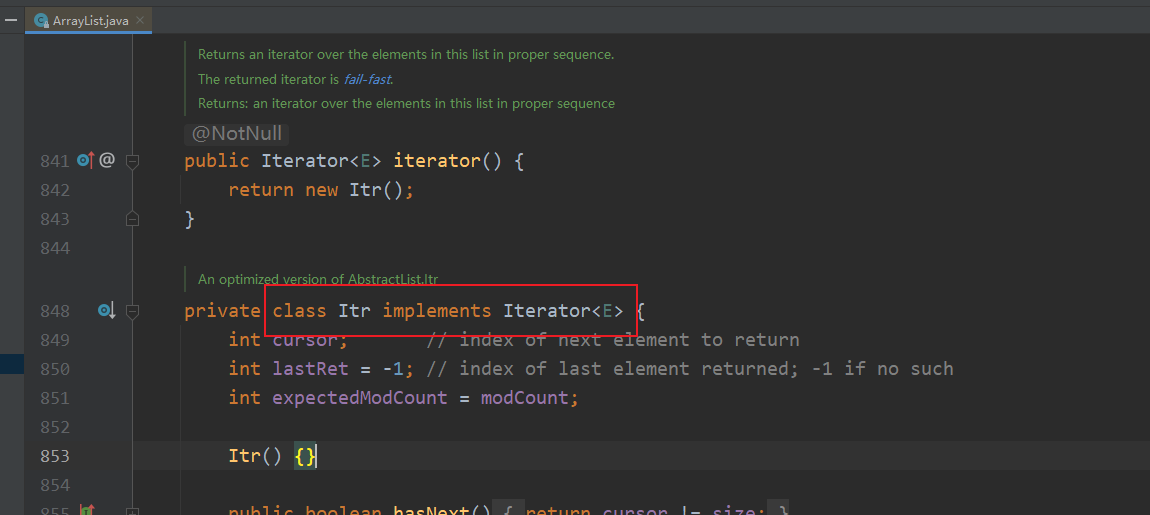
小结
优点
- 提供一个统一的方法遍历对象,客户不用再考虑聚合的类型,使用一种方法就可以遍历对象了
- 隐藏了聚合的内部结构,客户端要遍历聚合的时候只能取到迭代器,而不会知道聚合的具体组成
- 提供了一种设计思想,就是一个类应该只有一个引起变化的原因(单一责任原则)。在聚合类中,我们把迭代器分开,就是要把管理对象集合和遍历对象集合的责任分开,这样一来集合改变的话,只影响到聚合对象。而如果遍历方式改变的话,只影响到了迭代器
- 当要展示一组相似对象,或者遍历一组相同对象时使用,适合使用迭代器模式
缺点
- 每个聚合对象都要一个迭代器,会生成多个迭代器不好管理类
